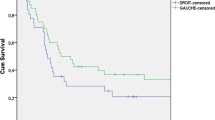Abstract
Objective
To study the association of a continent ileocecal valve and the degree of severity of the CT signs in patients presenting with large bowel obstruction due to colonic cancer.
Patients and methods
Sixty-six patients undergoing emergency surgery for confirmed obstructive colonic cancer were included. The CT examinations were analyzed without consultation of the surgical results. For each patient, the diameter of the cecum at its widest point and that of the last ileal loop were measured. The ileocecal valve was considered incontinent when there was a distension of the last ileal loop greater than or equal to 25 mm. Below 25 mm, the ileocecal valve was considered continent. The presence of CT signs of severity of the LBO was noted, i.e., intestinal pneumatosis, absence of contrast enhancement of the large bowel wall, defect in the large bowel wall, and presence of extra-digestive air and ascites.
Results
Among the 66 patients included, 42 had an incontinent ileocecal valve and 24 had a continental ileocecal valve. There was a statistically significant difference between the two groups in the diametrical measurements of the cecum’s widest point (mean diameter measured at 10.3 cm in patients with continent ileocecal valve vs 8.4 cm in patients with incontinent ileocecal valve, P = 0.0023). Patients with a continent valve had statistically higher rates of CT severity (79% vs 40%, P < 0.005). Perforation of the cecum remained rare (8%) and was only observed in patients with continent ileocecal valve in our series.
Conclusion
Continence of the ileocecal valve appears to be statistically correlated both with cecum distension and the presence of CT signs of severity in patients with obstructive colonic cancer. As such, its presence must be retained as a risk factor for a pejorative evolution of this type of LBO and must be specified in the CT report of these patients.






Similar content being viewed by others
References
Sielezneff I, Karoui M (2016) Prise en charge du cancer colique en occlusion: Rapport présenté au 118e Congrès français de chirurgie
Runkel NS, Schlag P, Schwarz V, Herfarth C (1991) Outcome after emergency surgery for cancer of the large intestine. Br J Surg 78(2):183–188
Longo WE, Virgo KS, Johnson FE, Oprian CA, Vernava AM, Wade TP, Phelan MA, Henderson WG, Daley J, Khuri SF (2000) Risk factors for morbidity and mortality after colectomy for colon cancer. Dis Colon Rectum 43(1):83–91
Alves A (2005) Postoperative mortality and morbidity in French patients undergoing colorectal surgery: results of a prospective multicenter study. Arch Surg 140(3):278
Sjo OH, Larsen S, Lunde OC, Nesbakken A (2009) Short term outcome after emergency and elective surgery for colon cancer. Color Dis 11(7):733–739
Tekkis PP, Kinsman R, Thompson MR, Stamatakis JD, Association of Coloproctology of Great Britain, Ireland (2004) The Association of Coloproctology of Great Britain and Ireland study of large bowel obstruction caused by colorectal cancer. Ann Surg 240(1):76–81
Ridereau-Zins C (2014) Imagerie du cancer colique. Journal de Radiologie Diagnostique et Interventionnelle 95(5):477–485
Sahoo MR, Kumar A, Jaiswal S, Basavaraja C (2013) Transverse colon perforation due to carcinoma rectum: an unusual presentation against Laplace’s law. BMJ Case Rep 2013:bcr2013008561. https://doi.org/10.1136/bcr-2013-008561
Davis L, Lowman RM (1956) An evaluation of cecal size in impending perforation of the cecum. Surg Gynecol Obstet 103(6):711–718
Gierson ED, Storm FK, Shaw W, Coyne SK (1975) Caecal rupture due to colonic ileus. Br J Surg 62(5):383–386
Johnson CD, Rice RP, Kelvin FM, Foster WL, Williford ME (1985) The radiologic evaluation of gross cecal distension: emphasis on cecal ileus. AJR Am J Roentgenol 145(6):1211–1217
Kottler RE, Lee GK (1984) The threatened caecum in acute large-bowel obstruction. Br J Radiol 57(683):989–990
Taourel P, Garibaldi F, Arrigoni J, Le Guen V, Lesnik A, Bruel JM (2004) Cecal pneumatosis in patients with obstructive colon cancer: correlation of CT findings with bowel viability. Am J Roentgenol 183(6):1667–1671
El-Amin LC, Levine MS, Rubesin SE, Shah JN, Kochman ML, Laufer I (2003) Ileocecal valve: spectrum of normal findings at double-contrast barium enema examination. Radiology 227(1):52–58
Kumar D, Phillips SF (1987) The contribution of external ligamentous attachments to function of the ileocecal junction. Dis Colon Rectum 30(6):410–416
Krajewski K, Siewert B, Eisenberg RL (2009) Colonic dilation. AJR Am J Roentgenol 193(5):W363–W372
Author information
Authors and Affiliations
Corresponding author
Ethics declarations
Conflict of interest
The authors declare that they have no conflict of interest.
Additional information
Publisher’s note
Springer Nature remains neutral with regard to jurisdictional claims in published maps and institutional affiliations.
Rights and permissions
About this article
Cite this article
Orbion, A., Mouman, A., Behr, J. et al. Correlation between a continent ileocecal valve and CT signs of severity in patients presenting with obstructive colonic cancer. Emerg Radiol 26, 277–282 (2019). https://doi.org/10.1007/s10140-018-01667-8
Received:
Accepted:
Published:
Issue Date:
DOI: https://doi.org/10.1007/s10140-018-01667-8




